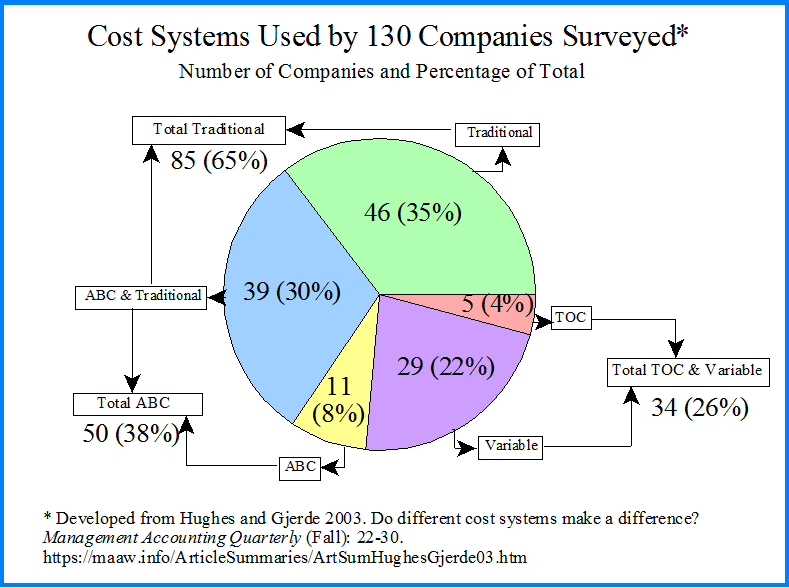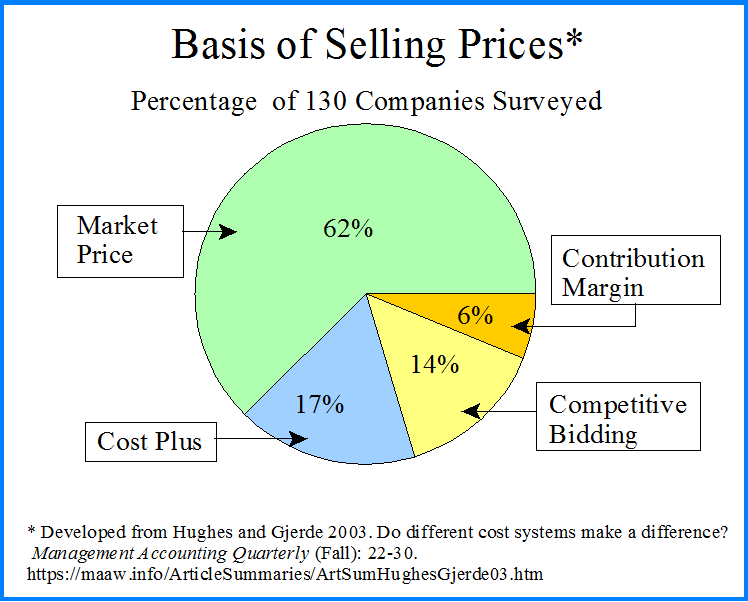
Summary by Denisse Reguerin
Master of Accountancy Program
University of South Florida, Fall 2004
ABC Main Page | Direct Costing Main Page |
TOC Main Page
Many factors, like complexity of the production process, frequency of operation at capacity, or the nature of competition, must be taken into account when deciding what cost system a company will adopt. “Given the internal and external pressures that a company faces, one cost system may be better suited to serve its needs than another.” In order to determine what types of cost systems U.S. manufacturing companies use and to examine the differences, if any, in the information generated from them, a survey was conducted on finance and accounting professionals at 130 U.S. manufacturing companies.
Cost Systems and Costing Issues
A significant percentage of product costs come from the overhead that is allocated to that product, but based on the costing system used, the amount allocated can vary greatly due to the fact that the different costing systems allocate overhead in very different ways. The traditional costing system uses a simple measure, such as machine hours, to allocate overhead, ABC uses cost pools and cost drivers to assign overhead costs based on usage, and in variable-costing systems, overhead is treated “as a collection of costs that are incurred to support all operations”, and therefore are not assigned to the product. In variable-costing systems, fixed costs are ignored for decision making purposes and all that matters, in the short run, when determining tactical production and pricing strategies are variable costs, whereas the traditional and ABC costing systems view all costs as variable in the long run, that will be assigned in some way to the product. Following is a brief summary of each of the three costing systems:
Traditional cost systems:
Financial accounting focus.
No causal relationship between the way overhead is allocated and actual production process.
May overcost simple products or products that rely on high usage of allocation base.
May undercost complex products or products that rely on low usage of allocation base.
Activity-based costing:
Typically designed to meet management decision making needs.
Causal relationships exist between overhead allocation and product usage.
Criticized for not “being strongly linked to quality and delivery strategies”.
Variable costing:
Only variable costs are included within product costs.
Fixed costs are lumped together and must be covered by the products’ contribution margin.
Viewed as being too focused on short-term decision making.
Competitive Considerations
Companies must evaluate their operating complexity, capacity considerations, and the nature of competition, before deciding which costing system to use. Companies should also make sure to adopt a system that will capture useful information within their decision models. For example in relation to operation complexity, a company that produces one product would not need to use a complex cost system since all the overhead is incurred to support that one product, whereas, companies that produce multiple products would have more complicated cost system decisions to make regarding the need for variable or full cost information and which costing system to use to determine this information. Capacity considerations include whether or not to include fixed-cost allocations in product costs when capacity is constrained or whether or not to include excess capacity costs within product costs. Finally, costing systems may influence product margins, decisions regarding whether or not to produce a product and the quality of the products, all of which will affect the way the company competes in both the price and nonprice aspects of competition.
The Survey
The survey results reported that out of the 130 companies surveyed, 46 use traditional cost systems, 11 use ABC systems, 39 use both traditional and ABC cost systems (for result reporting purposes, the ABC users were combined with the traditional and ABC users), and 34 use variable-cost and TOC systems. From that group 29 use traditional variable costing and 5 used TOC based costing. The following graphic illustration conveys these statistics as well as some additional combinations.

A summary of some of the other survey results appears in the tables below. The answers to most of the questions were based on a Likert seven-point scale where 1 indicates the most negative response, 4 indicates a neutral, mid-level, response and 7 indicates the most positive response.
Operating complexity
Across all 130 companies, Material costs averaged 53%, labor averaged 18% and overhead averaged 28% of product costs.
There where no statistically significant differences in the levels of automation or production flexibility within the three cost systems (all responses were above the midpoint between 4 and 5).
All cost system users believe their products and production process are a little more complex than the midpoint.
All responses were below a 3 on how adequate the presentation of idle capacity is in their cost system.
Capacity Considerations
The frequency of operating at capacity does not differ statistically among cost system users (both traditional and variable users were slightly above 4 (midpoint) and ABC users were slightly over 4.5)
Nature of competition
As illustrated in the graphic below, 62% of the companies set their selling prices based on market prices, 14% based on competitive bidding, 17% based on cost-plus, and 6% based on contribution margin.

There is a positive relationship between price competition and the emphasis for cost reduction.
Variable cost system users use accounting information to evaluate profitability more often (variable over 5 vs. traditional and ABC slightly over 4.5)
All cost systems reported about the same level of frequency of new product and major design changes.
Perception of cost system adequacy
All companies believed their cost systems adequately calculated product costs (all responses were between 4 and 5).
ABC and variable costing users found their systems more adequate at providing information for revenue enhancement and input for cost reduction efforts
than did traditional cost users.
Few Differences
Even though the survey results indicate that “there are few differences in the internal and external environments of ABC, traditional and variable-cost system users”, they indicated that ABC and variable-cost systems better serve users and that “the best system may integrate ABC and variable-cost system attributes”. The results also found that industry pressures did not influence the cost system used and that ABC systems were able to present cost of unused capacity more clearly than the other systems. The authors conclude this article by stating that some of the reasons for the lack of statistically significant environmental differences are due to the fact that “the survey does not measure the appropriate internal or external dimensions”.
________________________________________
Related summaries:
Abel, R. 1978. The role of costs and cost accounting in price determination. Management Accounting (April): 29-32. (Summary).
Bertini, M. and O. Koenigsberg. 2021. The pitfalls of pricing algorithms. Harvard Business Review (September/October): 74-83. (Summary).
Chenhall, R. H. and K. Langfield-Smith. 1998. The relationship between strategic priorities, management techniques and management accounting: An empirical investigation using a systems approach. Accounting, Organizations and Society 23(3): 243-264. (Summary).
Cooper, R., and R. S. Kaplan. 1998. The promise - and peril - of integrated cost systems. Harvard Business Review (July-August): 109-119. (Summary 1, Summary 2).
Govindarajan, V. and R. N. Anthony. 1983. How firms use cost data in price decisions. Management Accounting (July): 30-31, 34-36. (Summary).
Hinterhuber, A. 2008. Customer value-based pricing strategies: Why companies resist. Journal of Business Strategy 29(4): 41-50. (Summary).
Hinterhuber, A. and S. Liozu. 2012. Is it time to rethink your pricing strategy? MIT Sloan Management Review (Summer): 69-77. (Summary).
Jones, T. C. and D. Dugdale. 2002. The ABC bandwagon and the juggernaut of modernity. Accounting, Organizations and Society 27(1-2): 121-163. (Summary).
Kaplan, R. S. 1990. The four stage model of cost systems design. Management Accounting (February): 22-26. (Summary).
Kaplan, R. S. 1998. Innovation action research: Creating new management theory and practice. Journal of Management Accounting Research (10): 89-118. (Summary).
Kaplan, S. E. and J. T. Mackey. 1992. An examination of the association between organizational design factors and the use of accounting information for managerial performance evaluation. Journal of Management Accounting Research (4): 116-130. (Summary).
Kee, R. C. 2001. Implementing cost-volume-profit analysis using an activity-based costing system. Advances in Management Accounting (10): 77-94. (Summary).
Keys, D. E. 1994. Tracing costs in the three stages of activity-based management. Journal of Cost Management (Winter): 30-37. (Summary).
Keys, D. E. and R. J. Lefevre. 1995. Departmental activity-based management. Management Accounting (January): 27-30. (Summary).
Krumwiede, K. R. 1998. ABC: Why it's tried and how it succeeds. Management Accounting (April): 32-34, 36, 38. (Summary).
Landry, S. P., L. M. Wood and T. M. Lindquist. 1997. Can ABC bring mixed results? Management Accounting (March): 28-30, 32-33. (Summary).
Mangan, T. N. 1995. Integrating an activity-based cost system. Journal of Cost Management (Winter): 5-13. (Summary).
Martin, J. R. Not dated. Activity based management models. Management And Accounting Web. ABMModels.htm
Martin, J. R. Not dated. Chapter 7: Activity Based Product Costing. Management Accounting: Concepts, Techniques & Controversial Issues. Management And Accounting Web. Chapter7.htm
Martin, J. R. Not dated. Chapter 8: Just-In-Time, Theory of Constraints, and Activity Based Management Concepts and Techniques. Management Accounting: Concepts, Techniques & Controversial Issues. Management And Accounting Web. Chapter8.htm
Martin, J. R. Not dated. The contribution margin controversy. Management And Accounting Web. CMcontro.htm
Martin, J. R. Not dated. What is a cost accounting system? Management And Accounting Web. 5partsofcostsystem.htm
Martin, J. R. 2022. A note on pricing strategies. (Note).
Mecimore, C. D. and A. T. Bell. 1995. Are we ready for fourth-generation ABC? Management Accounting (January): 22-26. (Summary).
Palmer, R. J. and M. Vied. 1998. Could ABC threaten the survival of your company? Management Accounting (November): 33-36. (Summary).
Porter, M. E. 1980. Competitive Strategy: Techniques for Analyzing Industries and Competitors. The Free Press. (Summary).
Ruhl, J. M. and B. P. Hartman. 1998. Activity-Based Costing in the Service Sector. Advances in Management Accounting (6): 147-161. (Summary).
Sandison, D., S. C. Hansen and R. G. Torok. 2003. Activity-based planning and budgeting: A new approach. Journal of Cost Management (March/April): 16-22. (Summary).
Shim, E. and E. F. Sudit. 1995. How manufacturers price products. Management Accounting (February): 37-39. (Note).
Shim, E. D. and R. Lim. 2022. A survey of U.S. firms' pricing strategies and costing methods. Cost Management (May/June): 15-19. (Note).
Troxel, R. and M. Weber. 1990. The evolution of activity-based costing. Journal of Cost Management (Spring):14-22. (Summary).
Turney, P. B. B. 1990. Ten myths about implementing an activity-based costing system. Journal of Cost Management (Spring): 24-32. (Summary).
West, T. D. and D. A. West. 1997. Applying ABC to healthcare. Management Accounting (February): 22, 24-26, 28-30, 32-33. (Summary).
Zeller, T. L. 2000. Measuring and managing e-retailing with activity-based costing. Journal of Cost Management (January/February): 17-30. (Summary).